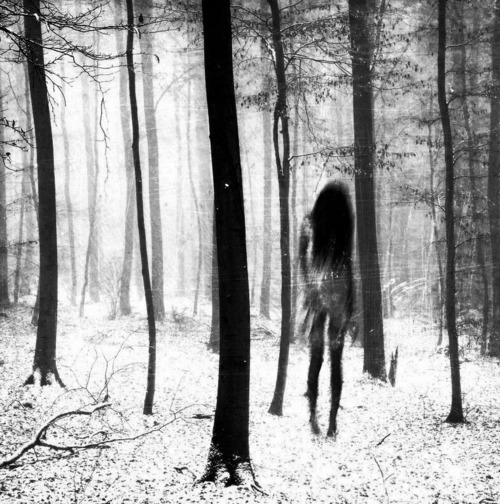
SCP-1692
Came Back Haunted

Unconfirmed photograph of SCP-1692-1, taken 18██
Special Containment Procedures
SCP-1692 is contained on a 2.77 square kilometer area of swampland located in central Louisiana, with chain-link and barbed wire fences along the perimeter. Outposts are to be stationed at 500 meter intervals, with regular patrols by guards posing as park rangers. In the event of a security breach by civilians, all possible measures are to be taken to retrieve the individual without use of lethal force.
Description
SCP-1692-1 refers to a corporeal entity of unknown composition located in St. Landry Parish, Louisiana. SCP-1692-1 most frequently appears as a prepubescent girl covered in mud, but has been observed taking on the forms of certain mammals and/or missing persons last spotted within █ meters of the enclosed region.
SCP-1692-2 refers to a sinkhole located at the direct center of the enclosed area that is filled in with mud and water. As of 2014, 31 sets of human remains and 24 animal remains have been discovered in SCP-1692-2. Fourteen of the bodies have been positively identified as locals declared missing between the years 191█ and 195█. New bodies have emerged from the pit sporadically, despite constant video monitoring of the area showing nothing entering the pit.
When a lone individual enters the affected area, SCP-1692-1 manifests more frequently, appearing to lead or otherwise attempt to induce the individual into following them. The individual inevitably becomes lost and all traces of them (including footprints, dropped items, and articles of clothing) disappear.
Between several hours and several weeks, an instance of SCP-1692-3 appears within the area and attempts to leave, if practicable. Recorded instances of SCP-1692-3 tend to bear a strong physical resemblance to the missing individuals, though typically deformed or otherwise mutilated, with signs such as:
- Missing limbs (with no sign of amputation)
- Missing organs (including total evisceration)
- Hydrocephalus
- Dissociative amnesia, often combined with depersonalization (living subjects retain little or no memory of recent events, or else describe extended periods of their own history as "dreamlike" or "unreal")
Of the recorded subjects, 84% have shown physiological inconsistencies, such as having the wrong blood type, differently aged organs, different hair or eye color, fluency in languages unknown to the subject, and impairments and/or improvements in certain mental faculties inconsistent with the subjects prior to exposure. An additional 54% bear signs of surgical incision or stitching indicative of vivisection.
With two notable exceptions, all instances of SCP-1692-3 have died soon after recovery due to these alterations.
History: SCP-1692 first came to the attention of the Foundation in 1938 after several children went missing near ██████ Lake, only to be recovered days later, with two of them missing fingers and toes, one with extra fingers, and three others with differently colored eyes and hair. While scouring the region, █ local officers similarly disappeared, with one Caucasian officer being recovered in a delirious state, claiming to be an African-American male named ██████ ████.
Foundation personnel on site soon discovered what appeared to be a freshly deceased body of a young child missing its legs and much of its head above the jawline, with skin grown over the severed ends. The body matched the physical description and clothing of a Bobby Dunbar, who had gone missing in the area some 25 years earlier, and was allegedly found months later alive and well. The body was placed into cold storage, as decomposition began setting in once it was disturbed.
Interviews with the now-adult Bobby Dunbar provided no pertinent information regarding the body, though had mentioned in an earlier interview a memory of "the other boy on the wagon" but could provide no further details. The Foundation began investigating the case, and found that the boy recovered by the Dunbar family had been in the custody of one William Cantwell Walters who claimed the boy to be Charles B. Anderson, the son of a woman who worked for him, who subsequently filed suit against the Dunbar family for custody of the boy. Due to matching physical evidence, and the boy himself identifying Mrs. Dunbar as his mother, the court ruled in favor of the Dunbar family.
The man identified as Bobby Dunbar lived out his life and died in 1966. DNA testing conducted in 2004 revealed that the man known as "Bobby Dunbar" was not in fact related to the Dunbar family. DNA from the body in Foundation custody was found to have been severely mutated via hydrolytic deamination.
Incidents continued to emerge within the region, leading to a Foundation quarantine of the affected area in 1939, occasionally expanded upon further discoveries of SCP-1692-3 instances. A young woman was recovered by the Foundation missing her left eye and bearing stitches along her left jawline. From her testimony, details regarding SCP-1692-1 and -2 were discerned for the first time, and SCP-1692-2 was located. From SCP-1692-2, two bodies were recovered, one of which bore a strong resemblance to the young woman, who vehemently denied it was in any way related to her. The body was missing portions of the left side of its head, including its left eye socket.
The woman remained on-site for a time before being administered amnestics and released under covert monitoring, where she lived out her natural life without any incident. DNA testing conducted years later found that her DNA did not match those of family members, and the recovered body could not be conclusively identified.
Once video surveillance of SCP-1692 was technologically feasible, incidents of SCP-1692-1 sightings and recovery of bodies have dropped off dramatically. As a result, animal corpses have begun to emerge from SCP-1692-2, bearing similar signs of hydrolytic damage to their DNA.
